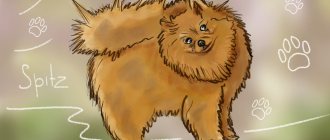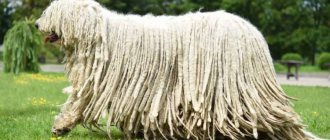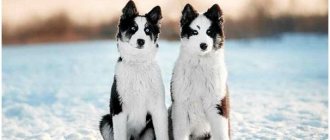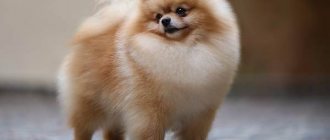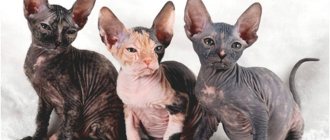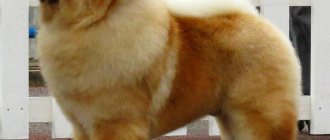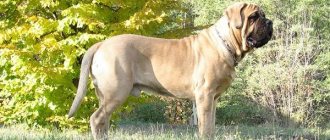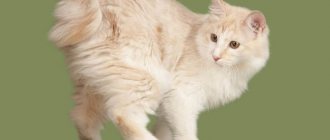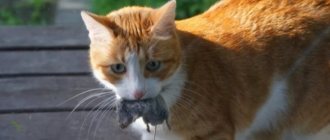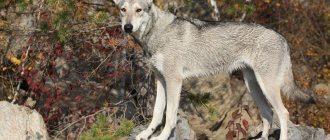A barking dog can be a real nuisance, especially if you live close to neighbors. You can train your dog to bark less, but you can also choose a breed with a low tendency to bark. For example, some breeds were bred to be "barking" hunting dogs to warn of prey. And other dogs are silent and remain unnoticed, this helps them quietly sneak up and catch the game.
Breeds that bark less are more confident, have a daily routine, and are comfortable with their family.
Dogs that are prone to barking may be experiencing separation anxiety, various phobias, or simply seeking attention. They may bark out of excitement, anxiety or boredom. This is their natural way of communicating, and owners must understand the reasons for barking before they can address their pet's behavior.
If your dog barks, you face a fine. How to avoid it?
Here are 15 generally quiet dog breeds that make great companions, especially if your neighbors are noise sensitive.
AFGHAN HOUND
Photo: Glow Images, Inc/Getty Images
Afghan Hounds are generally quiet and independent, playful and affectionate with their loved ones. They are very loyal to their families. These rather energetic and slightly stubborn dogs are not suitable for every home, and their silky coat requires special, careful care.
MORE DETAILS
Breed characteristics and character
The Basenji is a unique dog breed with a centuries-old history. It appeared more than 4000 years ago in African countries and was an indispensable assistant in hunting. The non-barking Basenji dog was even mentioned in ancient Egyptian myths and was of great value to the people of that time as a loyal friend and companion.
Due to the fact that the Basenji breed was not artificially bred, it has retained hunting instincts and practically does not accept training. But the African silent bird carries out simple commands necessary for everyday life without problems.
For the most part, the success of training depends on the relationship between the owner and the dog. If you establish contact with your dog, then throughout its life it will be interested in acquiring new knowledge.
But you should not punish a puppy for refusing to train, otherwise in the future she will simply refuse altogether. More often it is worth switching her attention to games and giving her a rest between classes.
The main feature of this dog is the absence of barking, typical of other breeds. This does not mean that she does not bark at all, but the Basenji's bark has a higher pitch due to the different structure of the larynx.
The African silent dog is an extremely clean dog that washes itself with its paws like a cat and brings virtually no smell into the house. And also some owners of their reviews characterize the Basenji as a hypoallergenic breed, but each dog is individual and this should be taken into account when buying a puppy.
This dog has a very cheerful and playful character, which is not suitable for sedentary people. The dog does not accept training, but willingly engages in small hunting due to its remaining hunting instincts.
They will be a faithful friend for many years, as they become strongly attached to their owner and will diligently protect him from unfamiliar people. They are not aggressive towards children and enjoy playing outdoor games with both adults and children.
AKITA INU
- Dog breeds / large / for protection / for apartments / guard / do not bark
Photo: Sandra Schmid/Getty Images
Akitas make excellent guard dogs and usually bark only to warn of danger. They are very loyal and often form strong bonds with just a few people, and stay aloof from strangers. Constant training is a must as Akitas are a bit stubborn.
MORE DETAILS
Add to cart
Quick view
Compare
Close
BOZITA X-LARGE dry food for adult dogs of large breeds with normal activity
5 200,00 ₽
Bullmastiff
Despite its large size and sometimes rather menacing appearance, the bullmastiff, like Hagrid from Harry Potter, surprises with its good nature and peaceful character. These dogs rarely vocalize and almost never bark, sometimes preferring to snore and grumble if they still need to “talk” with their owner.
Bullmastiffs do an excellent job of guarding and are very obedient and peaceful. They are able to live even in a small city apartment and do not require any special or tedious personal care. Although they take up quite a lot of space, because the dog weighs neither more nor less - from 40 to 60 kg, and their height reaches from 60 to 69 cm.
BASENJI
- Dog breeds / small / smart / guard / don't bark
Photo: Tara Gregg/Getty Images
Basenjis don't bark. Instead, the dog howls or even sings, which is very similar to “yodeling.” They are not particularly noisy, but when excited, these energetic dogs will occasionally yelp, whine or "sing out Tyrolean tunes."
MORE DETAILS
Bulldog
Looking at squat dogs with a fairly strong physique, one can assume that they are active, energetic, noisy, and bark often and loudly. But this is a misleading impression. Bulldogs have a calm, peaceful and kind disposition. Perhaps due to this nature or the peculiarities of the physical constitution, representatives of the breed rarely bark and almost never make sharp, loud sounds.
Dresses for any occasion: trendy denim items this spring that suit everyone
Miso and natto: scientists are sure that fermented soybean dishes prolong life
An attractive image is easy to maintain even after 50 years: 10 fashionable men's haircuts
CHOW-CHOW
- Dog breeds/medium/for apartments/guard/do not bark
Photo: mimilasouris7/Getty Images
The Chow Chow is a resilient and independent dog breed known for its bear-like appearance and bluish-black tongue. Chows usually do not bark unless they sense danger. Even so, they are not particularly noisy. They are sometimes aggressive, but mostly because they want to protect themselves or their family.
MORE DETAILS
How to teach a dog not to make noise in the home office? Catch this life hack!
Breed characteristics
Basenjis attract people with their aristocratic appearance, lack of bark and smell. The breed was formed in a natural environment, and humans did not take part in this process. The way of life and living conditions gave the animal smooth, long muscles that provide freedom of movement and excellent coordination. Representatives of the breed have lively facial expressions due to wrinkles between the ears.
Table 1. Basenji standard
| Criterion | Description |
| Scull | Flat, refined, narrow cheekbones |
| Bite | Full, scissor-shaped, with vertical teeth |
| Eyes | Dark, almond-shaped, slightly slanted, giving the muzzle a sly expression |
| Ears | Small in size, erect, without kinks, with a slight forward inclination. When the ears are folded, wrinkles form on the forehead |
| Neck | Strong, long |
| Frame | The back is straight, the chest is oval, the ribs are protruding, the stomach is tucked, the lumbar is short |
| Tail | Tightly coiled, ring-shaped, high and adjacent to the sacrum |
| Legs | Strong, muscular, with closed toes, rounded paws |
| Coat | Short, fine and soft coat that lies close to the skin |
| Height Weight | Male - 43 cm/11 kg, female - 40 cm/9.5 kg |
Basenji color
The FCI recognizes four types of Congo Terrier colors:
- red and white;
- bright black and white;
- deep black with red-red tan, white “melon seed” shade, spots above the eye sockets, on the muzzle and cheekbones (tricolor);
- red with black stripes; brighter combinations (brindle) are considered winning.
Basenji color options
Since we are talking about a native breed, the palette is not limited to the options described above. The following types of colors are found in nature:
- saddle cloth with black mask;
- pale yellow;
- blue.
On a note! A common feature for all variations is white spotting on the toes and tip of the tail. However, the main color should occupy a larger area of the body than white.
BORDER COLLIE
Dog breeds / for children / herding / medium / smart / do not bark
Photo: gentledogtrainers.com.au
Intelligent and athletic, Border Collies tend to remain silent until they feel it is necessary to communicate something important. Caring for their coat is necessary: it needs to be brushed several times a week. Exercise needs are also quite high, but training is usually not difficult.
Add to cart
Quick view
Compare
Close
Monge Dog Fresh Chunks in Loaf canned food for dogs duck meatloaf
150,00 ₽
Add to cart
Quick view
Compare
Close
Monge Dog Fresh Chunks in Loaf canned food for dogs meatloaf veal
150,00 ₽
MORE DETAILS
Breed care
Basenji needs clothes. Therefore, for the winter, he needs overalls for walks in the fresh air. They are protected from cold and drafts. At the same time, high summer temperatures are tolerated perfectly, without interfering with walks and fun even in the midday heat.
Attention! Nyam Nyam Terriers are afraid of water. Therefore, it is forbidden to force them to swim. According to one version, the phobia is genetically based due to the fear of crocodiles.
Due to water intolerance, swimming is also contraindicated. The fur should be brushed periodically. If necessary, wipe the body with wet wipes. They also perform standard hygiene procedures for caring for the oral cavity and ears.
Basenjis need to have their coat brushed periodically.
Walks
Ensure sufficient physical activity. It is good to find an area where free walking is possible, without a leash, so that the pet can splash out its energy. A great option is to take your dog with you while jogging, traveling through the forest, or hiking. Hours of walking do not tire the animal at all. When given enough exercise, Basenjis are sweet and quiet at home.
GREYHOUND
- Dog breeds / large / hunting / fast / do not bark
Photo: The Spruce/Kevin Norris
Greyhounds are one of the few dog breeds that can be called quiet. They require a moderate amount of exercise. Some of them develop very close bonds with their family and express their resentment when they are left alone. Behavioral training can fix this.
MORE DETAILS
Who's that barking at home?
Reviews
In general, there are positive reviews about the Basenji, but often owners are faced with the destructive behavior of their pet. Most note the dog’s lively and energetic disposition, while some turn to dog handlers to correct unwanted behavior.
A dog of this breed is suitable for active and responsible people who will be able to raise their pet from the first days of its life in a new family. To avoid the development of bad habits in your dog, it is recommended to consult a specialist and undergo a general training course. The breed is completely unsuitable for lazy people and those who do not have enough time to work with an independent dog.
NEWFOUNDLAND
- Dog breeds / for children / large / for protection / guard / do not bark
Photo: Alexandra Draghici/Getty Images
The Newfoundland is an affectionate dog that is extremely loyal to its people. Barking is not typical unless the dog needs to alert you to something. They need a lot of exercise, but not as much care as they seem. Most of them are highly trainable.
MORE DETAILS
ST BERNARD
- Dog breeds / for children / large / for protection / guard / do not bark
Photo: Purple Collar Pet Photography/Getty Images
Saint Bernards are usually silent unless they feel they need to warn you of danger. In general, these are very loyal and affectionate dogs that strive to please their owner. You need to spend time training this breed, because with such a large size, they need to be controlled.
Add to cart
Quick view
Compare
Close
Mnyams canned food for dogs Terrine a la Versailles (veal with ham)
Rating 5 out of 5
150,00 ₽
MORE DETAILS
What dogs can't bark at all?
The only non-barking dog breed in the world is the Basenji. The absence of barking is explained by the specific structure of the pharynx, which prevents the formation of a characteristic sound. Despite this feature, it cannot be said that this dog is completely without a voice. Instead of the usual yelps, she communicates using purrs, howls, snorts and whines.
Another advantage of representatives of this breed is the absence of an unpleasant odor. Basenjis are famous for their cleanliness and take care of their own hygiene, licking themselves like cats.
“
More about Basenji
SHIBA INU
- Dog breeds / for guarding / medium / for apartments / guard / do not bark
Photo: Onay Jakobov/Getty Images
The Shiba Inu is a generally quiet dog that may seem reserved at first, especially around strangers. These dogs are independent but devoted to their family. They require minimal grooming and have average exercise needs.
MORE DETAILS
WHIPPET
- Dog breeds / medium / hunting / fast / do not bark
Photo: Nicole Hammond/Getty Images
Whippets are generally quiet dogs and are playful and affectionate with their family. Physical exercise is necessary, the load is from moderate to high. And since whippets can be stubborn and easily distracted, training must be consistent.
MORE DETAILS
Cavalier King Charles Spaniel - a small dog with an interesting destiny
Quiet dogs
These dogs know how to bark, but due to their nature, they just don’t really like to do it. Therefore, those who cannot stand loud barking when choosing a puppy should pay attention to one of these breeds.
Saluki
Graceful and free-spirited, the Saluki is an Arabian greyhound. She has the purest genes, a keen sense of smell and an elegant, flexible physique. The ancient Arabs considered it a gift from the Almighty and took good care of it. In response, Salukis helped humans hunt small-hoofed animals. To catch up with a gazelle, this animal can reach the speed of a leopard (up to 70 km/h).
Saluki has a calm, but strong-willed disposition. Its barking can be heard extremely rarely, only in extreme situations. She does not exhibit protective qualities and is more suitable as a companion for dynamic people who love long travels.
Horseback riding and cycling are the best way to get along with the athletic Persian Greyhound. The breed has retained excellent hunting performance and is suitable for hunting animals in open areas.
Saluki is a gentle and sophisticated creature. She is demanding of affection and attention. Loves owner and children. He does not accept other four-legged animals into his company. She does not like noisy games, and a crowd of people puts her in a state of stress. She is a loner and is content to communicate only with close people.
The breed is more popular in Arab countries. In Russia there are several official nurseries dedicated to breeding this ancient and silent breed. She is suitable for experienced breeders who have the time and desire to establish close contact with the sophisticated and thoughtful “Persian princess”.
You can buy an elite Saluki puppy for a price ranging from 35 to 60 thousand rubles. You should only buy a pet from breeders with a long-standing and positive reputation.
Shiba Inu
Another representative of non-barking dogs is the Shiba Inu. A small but very cunning Inu from the island of Honshu. A child of the land of the rising sun and a descendant of wild dogs that lived in Japan BC.
Shiba Inu (Shiba Inu) is classified as a hunting dog. Its appearance remained original and was not subject to the intervention of breeders. Shiba is the property and pride of the Japanese people. A miniature representative of the Spitz-type.
Shiba's bark is similar to a shrill cry that she makes when alarmed, frightened, or as a sign of protest. The rest of the time, the pet is silent and communicates with the person through facial expressions, at the level of psychological perception. This dog knows how to express a feeling of joy and pleasure with a smile.
Little Innu is a one-owner dog. Loyal, reasonable and fair. She does not tolerate despotic treatment and will never forgive anyone who raised a hand against her. At heart, the Shiba Inu is a “samurai” who will not bow his head and will not grovel before a person for a piece of meat. Dealing with it is not easy. Only through physical and mental training, affection, persuasion, and sometimes your own example, can you come to an agreement with this rebellious and proud dog.
CAVALIER KING CHARLES SPANIEL
- Dog breeds / small / for apartments / do not bark
Photo: Bigandt_Photography/Getty Images
Cavalier King Charles Spaniels are not known to bark. But this happens if the dog craves attention or feels neglected. The Cavalier King Charles Spaniel may bark due to anxiety, fear, loneliness or separation anxiety.
MORE DETAILS
Add to cart
Quick view
Compare
Close
CeramikArt ceramic box for storing dog treats white
450,00 ₽
Add to cart
Quick view
Compare
Close
Ceram bowls in der Trixie black
2 850,00 ₽
SHARPEI
- Dog breeds / medium / smart / for apartments / guard / do not bark
Photo: zokov/Getty Images
Shar Peis bark very rarely. This is an ideal choice if you prefer a calm breed. Shar Peis are a strong, loyal and loving breed of dog. These "Chinese" maintain a zen-like calm unless they sound the alarm about a potential threat.
MORE DETAILS
Ekaterina Varnava, Olga Orlova, Michelle Pfeiffer published touching zoo photos on Instagram
JAPANESE CHIN
- Dog breeds / small / for apartments / do not bark
Photo: Niconic_Photography/Getty Images
The Japanese Chin is not prone to barking. This is a family breed, calm and pleasant, and gets along well with children. They are often compared to cats because chins love to rest on their owner's lap. These dogs may bark from separation anxiety or if they have been neglected.
MORE DETAILS
GERMAN DOG
- Dog breeds / large / for protection / guard / do not bark
Photo: Earl-Wilkerson/Getty Images
Great Danes are a breed of gentle giants known for being highly protective of their home and loved ones. This is one of the quietest breeds. They rarely bark unless there is a good reason: to warn of danger, for protection, to greet, or out of boredom if they are ignored or left alone for too long.
MORE DETAILS
Add to cart
Quick view
Compare
Close
Hunter dog harness Tripoli nylon St. pink, reflective
850,00 ₽
Add to cart
Quick view
Compare
Close
DARELL Synthetic reflective collar “ECO-LUMI” 20mm 32-41cm
200,00 ₽
Bernese Mountain Dog
Large, good-natured dogs native to the Swiss Alps have a deep voice, but rarely use it. With its voice, the animal gives a signal to the owner in times of danger or if necessary to attract attention.
These are peasant dogs suitable for hard work, including horse-drawn work for transporting cargo on small carts. Bernese are versatile: they guard the house, herd livestock and look after children.
The height of males is 61-71 centimeters, females - 58-69 centimeters, weight, respectively, 38-50 kilograms and 36-48 kilograms. These peaceful and quiet pets, unfortunately, have a short life expectancy of 6-8 years.
It is recommended to keep the dog in a private home, where it will not be crowded and has more opportunities for energetic runs, and the pet’s sociable nature will make it a faithful friend for families with children.
RHODESIAN RIDGEBACK
- Dog breeds / for children / large / smart / do not bark
Photo: olgagorovenko/Getty Images
Ridgebacks generally bark little. They may bark to alert you to something unusual, and some may bark when they are bored, but they are not a yapping breed. This African breed was bred to hunt and guard their home.
MORE DETAILS
What breed of dog to choose
Breeds to Avoid
Unlike their quiet cousins, several dog breeds are known for their noisy behavior. These include: Yorkshire terriers, hounds, basset hounds, Spitz dogs and shelties.
We will be grateful if you support our materials in the Zen channel. Thank you!
If you find an error, please select a piece of text and press Ctrl+Enter.
Use of materials on other resources is possible only with the written consent of the editors and co-authors of the articles
Health and illness
Modern representatives of the Basenji breed are the result of natural selection of many generations, so they have good health. But this does not eliminate the need to monitor the pet’s condition. Be sure to get your dog vaccinated and regularly treat it against parasites. With proper care, life expectancy reaches 12-16 years.
Possible diseases that Basenjis are susceptible to:
- Fanconi syndrome
: a disorder of kidney function, in which an increased release of substances important for life (proteins, glucose) occurs from the body. The disease can be diagnosed by testing urine for sugar. It is impossible to completely cure the disease, but its symptoms can be corrected by taking medications prescribed by a veterinarian. Warning signs: the pet drinks a lot, urinates often. A urine test reveals high levels of glucose when levels in the blood are normal. - Hypothyroidism
is a disease of the thyroid gland associated with decreased production of hormones. A sick animal has excess weight, dull hair, dandruff, weakness, swelling of the paws and head, and anemia. A blood test to measure the level of thyroid hormones helps identify the disorder. - Malabsorption
is a malabsorption of nutrients in the intestine. The animal suffers from diarrhea and loses weight. You need to take medications prescribed by your doctor. - Progressive retinal atrophy
is a disease of genetic nature. It leads to a gradual deterioration of vision up to its complete loss. - Epilepsy
is a disease of the nervous system that is inherited. Manifested by sudden convulsions and fainting. It is incurable, but the manifestations of the disease are blocked by drugs selected by the doctor. - Hemolytic anemia
is a consequence of increased premature destruction of red blood cells. Caused by a genetic defect, there is no cure. - Hip dysplasia
is a congenital abnormality in the structure of the joint. Depending on the severity, it leads to dislocations, lameness or complete inability to move independently. X-rays help detect the defect, and a good breeder will examine the puppies before handing them over to the owner.
How much does it cost and where can I buy it?
In Russia there are several kennels of the breed and the geography is very wide: a dog can be bought from Moscow to Vladivostok.
When choosing a puppy, you should pay attention to the reputation of the nursery or breeder, try to find out whether there were any sick puppies in earlier litters from these parents. The puppy must be well-fed and active. If possible, look at both parents. The puppy should not have any discharge from the nose or ears.
Puppy price: 20,000 – 60,000 rubles
Major diseases
On average, the Basenji lives 10-14 years , maintaining its activity. There are a number of diseases to which this breed is susceptible:
- Fanconi syndrome. Kidney disease that affects the normal processing of sugars and proteins. Most often diagnosed at 4-7 years of age. It was previously considered fatal, but today there are treatments for the syndrome. The offspring of some sires are more susceptible to the disease, although it has not been scientifically proven that the syndrome is transmitted genetically.
- Hemolytic anemia. It mainly affects puppies. Incurable, mortality rate - 100%. Reliable breeders test for the presence of the disease and do not sell puppies with identified signs of the disease.
- Coloboma. Cleft iris. Most often it is a hereditary factor. Individuals with diagnosed coloboma are not allowed for further breeding.
- Joint dysplasia. Despite their small size, Basenjis sometimes show signs of joint dysplasia. Such individuals should not be involved in divorce. This disease requires surgery for complete cure.
Shar Pei
Charming “plush” folds and the wise look of the ancient Eastern philosopher are signs by which you can unmistakably recognize a Shar Pei.
Many people do not take these dogs seriously, and rightly so. After all, Shar Peis are known for their strength, agility and good guard qualities.
They are not large in size and do not need much space, which is why residents of city apartments so often have them.
IMPORTANT!
Shar Peis are calm, balanced and devoted to their owners, but they are characterized by an independent disposition and self-centeredness, which is why they are sometimes stubborn.
They rarely bark, only when they need to protect the territory or if something has angered them.
Education and training
Due to their independence and natural intelligence, Basenjis are not easy to train. In this process, it is important to limit the pet’s freedom of choice without the use of violence.
One of the main commands, “come to me,” is practiced using a roulette leash.
Release the leash and let the dog move as far away as possible. When the leash ends, give the command “come to me.” Unable to move further away from the owner, the pet will run towards him, you need to reward him, praise him, give him a treat. Commands should be practiced constantly, at different times and under different conditions.
Training and raising a Basenji requires love and patience, and the ability to limit choices without using violence.
Basic principles of education:
- always thank and reward your pet for following commands;
- do not use violence or punishment;
- practice commands constantly;
- The dog should be trained not only individually, but also in a group. She carefully watches and remembers how other group members carry out commands.
From an early age, the dog should be taught that the owner can get into his mouth and get food out of it. This manipulation will help protect the pet if the owner promptly and calmly takes the dirt that he picked up on the street from his mouth.
The dog must eat food in a certain place; do not treat the dog near the table or refrigerator. Then she will climb onto the table and into the refrigerator on her own.
Basenjis require a lot of attention and love; communication with a pet will protect the house from pogroms caused by dogs deprived of attention.

